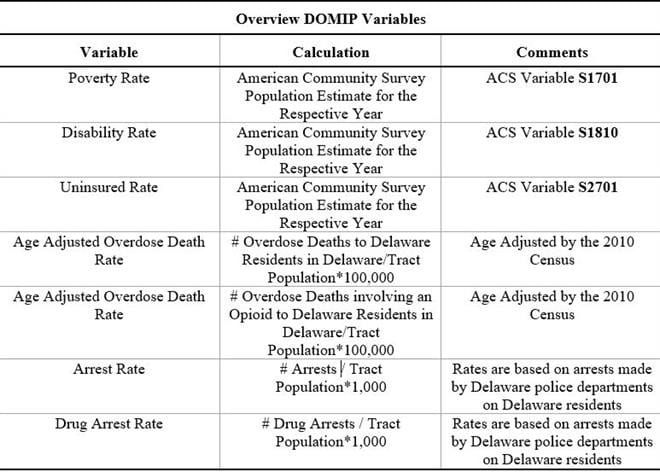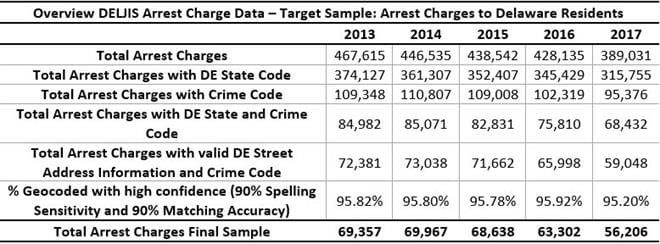Overview
The Delaware Opioid Metric Intelligence Project (DOMIP) – provided community surveillance capabilities in Delaware to help reduce its prescription and illicit drug problems. DOMIP achieved this by integrating data-on overdose deaths, crime, population characteristics and community resources into a user-friendly web application called the DOMIP Mapping app. The mapping app contained multiple years of integrated data that allowed for unprecedented community surveillance, statistical analysis and mapping of a wide range of opiate and crime-related metrics, at the US census tract, zip code, Delaware House District and county levels. Users could also select layers to view where overdose deaths were concentrated and plot treatment resources therein. Such information informed best practices that assisted efforts to reduce the negative impact of the opioid problem on all Delawareans. The figures presented here do not reflect the opinions of the NIJ.
Data Sources
Overdose Death Data: Postmortem toxicology reports were conducted by medical examiners from the state of Delaware. The medical examiners investigate and certify the cause and manner of death of those who die within the state’s boundaries and fall under the statutory jurisdiction of the office. Suspected overdose deaths identified by a medical examiner were then subjected to further toxicological examination. The Forensic Toxicology Unit worked in tandem with pathologists in the ME Unit to determine what substances were present in the decedent at the time of death. The toxicology report was then reviewed by the assigned pathologist and a cause and manner of death was determined. Assignment of decedents to census tracts was based on the home address of the decedents. Cases with home addresses outside the state of Delaware or that were determined to be homeless were excluded. Addresses were geocoded using ESRI ArcGIS address locators and, finally, mapped to census tracts.
Crime Data: The Delaware Criminal Justice Information System (DELJIS) provided data on criminal incidents reported to the police or observed by the police and arrests conducted by Delaware law enforcement. Addresses and Names fields were cleaned using regular expressions and addresses were geocoded using ESRI ArcGIS address locators and mapped to census tracts (the majority of the incident data was already geocoded). Cases with home addresses outside the state of Delaware or that were determined to be homeless were excluded. Drug crimes were identified via the provided crime codes that are also used to report to the National Incident-Based Reporting System (NIBRS). Total arrests included all types of arrests (including non-serious offenses, in contrast to other crime reports: https://sac.delaware.gov/wp-content/uploads/sites/64/2017/04/Crime-in-Delaware-2009-2013-min.pdf).
American Community Survey: “The American Community Survey (ACS) helps local officials, community leaders, and businesses understand the changes taking place in their communities. It is the premier source for detailed population and housing information about our nation”(https://www.census.gov/programs-surveys/acs/). In 2010, the ACS replaced the long form of the decennial census as the only national source of socio-economic data for smaller areas like neighborhoods (census tracts – DOMIP uses census tracts as proxies for neighborhoods). The ACS is a constantly ongoing survey that offers a wide variety of socio-economic information (the variables we used are listed below).
Variables Overview

Overdose Deaths

Overdose death cases were received from Delaware’s Division of Forensic Sciences. Overdose statistics presented were based on the substances found to be present in the body at the time of death as determined by the DFS toxicology reports. Assignment of decedents to census tracts was based on the home address of the decedents. Cases with home addresses outside the state of Delaware or that were determined to be homeless were excluded.
Arrests

The Delaware Criminal Justice Information System (DELJIS) provided data on criminal incidents reported to the police or observed by the police and arrests conducted by Delaware law enforcement. Cases with home addresses outside the state of Delaware or that were determined to be homeless were excluded. Drug crimes were identified via the provided crime codes that are also used to report to the National Incident-Based Reporting System (NIBRS). Total arrests include all types of arrests (including non-serious offenses), in contrast to other crime reports.
